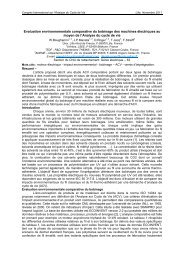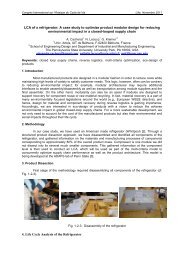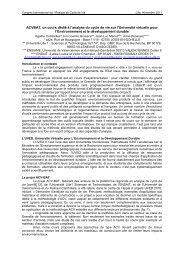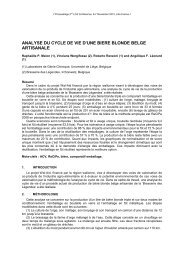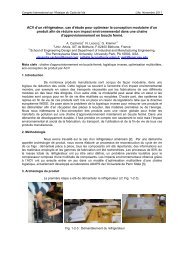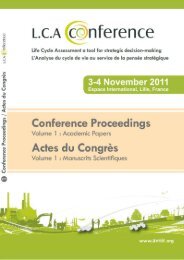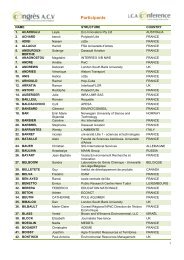Assessing Temporary Carbon Storage in Life Cycle Assessment and ...
Assessing Temporary Carbon Storage in Life Cycle Assessment and ...
Assessing Temporary Carbon Storage in Life Cycle Assessment and ...
You also want an ePaper? Increase the reach of your titles
YUMPU automatically turns print PDFs into web optimized ePapers that Google loves.
Explicit consideration of impacts <strong>and</strong> relevant tim<strong>in</strong>g also changes the relative importance of different<br />
greenhouse gases. It would reduce the relative importance of methane <strong>and</strong> <strong>in</strong>crease focus on the<br />
longer-lived greenhouse gases, <strong>in</strong>stead.<br />
7.4.1 Introduction<br />
Climate change is now recognised as a global problem, <strong>and</strong> the global community is seek<strong>in</strong>g costeffective<br />
means of reduc<strong>in</strong>g the net emission of greenhouse gases to the atmosphere. The use of trees,<br />
or more correctly the use of the biosphere for carbon storage, is often considered as a cost-effective<br />
means of reduc<strong>in</strong>g net emissions to the atmosphere. Trees are used as a means to ‘buy time’. The<br />
question is addressed here whether trees, or the biosphere more generally, can make a useful<br />
contribution to reduc<strong>in</strong>g net emissions to the atmosphere. This discussion is based on previous work<br />
(Kirschbaum 2003a, 2003b, 2006) <strong>and</strong> is developed further from those publications <strong>in</strong> the follow<strong>in</strong>g.<br />
It essentially comb<strong>in</strong>es considerations of feedbacks via natural carbon reservoirs, especially the<br />
world’s oceans, with an explicit def<strong>in</strong>ition of the key climate-change impacts we are concerned about.<br />
It leads to important consequences for the choice of tim<strong>in</strong>g of emissions <strong>and</strong> emission reduction<br />
activities.<br />
Importantly, it allows a dist<strong>in</strong>ction to be made between net emissions <strong>and</strong> the atmospheric<br />
concentration of greenhouse gases. Net emissions are not important on their own, but it is the ultimate<br />
atmospheric concentration that leads to radiative forc<strong>in</strong>g <strong>and</strong> thus climatic impacts. In the case of fossil<br />
fuel emissions, there tends to be a tight l<strong>in</strong>kage between emissions <strong>and</strong> resultant atmospheric<br />
concentrations. There is little choice <strong>in</strong> the tim<strong>in</strong>g of emissions. Fossil fuels are emitted when they are<br />
needed to produce a service, such as generat<strong>in</strong>g electricity or driv<strong>in</strong>g a car. The tim<strong>in</strong>g of emissions is<br />
therefore determ<strong>in</strong>ed by the dem<strong>and</strong> for the ultimate service.<br />
In the case of biospheric carbon stocks, however, there is more choice <strong>in</strong> affect<strong>in</strong>g the tim<strong>in</strong>g of<br />
emissions, <strong>and</strong> more choice <strong>in</strong> affect<strong>in</strong>g carbon-stock changes that are not associated with any end-use.<br />
L<strong>and</strong> can be converted between non-productive grassl<strong>and</strong> <strong>and</strong> forests, with large carbon implications,<br />
or productive l<strong>and</strong> can be managed <strong>in</strong> different ways to achieve lower or higher carbon stocks without<br />
necessarily affect<strong>in</strong>g the service the products are put to. S<strong>in</strong>ce these carbon stock changes can be<br />
undertaken at different po<strong>in</strong>ts <strong>in</strong> time, the importance of tim<strong>in</strong>g needs to be explicitly addressed.<br />
7.4.2 The <strong>Carbon</strong> <strong>Cycle</strong><br />
The World conta<strong>in</strong>s massive carbon pools that naturally <strong>in</strong>terchange carbon between each other<br />
(Kirschbaum 2003b). The pr<strong>in</strong>cipal ones are the atmosphere, the oceans <strong>and</strong> the l<strong>and</strong> area. The<br />
<strong>in</strong>terchange between the atmosphere <strong>and</strong> these other carbon pools is diagrammatically represented <strong>in</strong><br />
Figure 7.4.1.<br />
39



